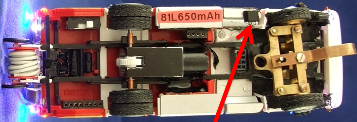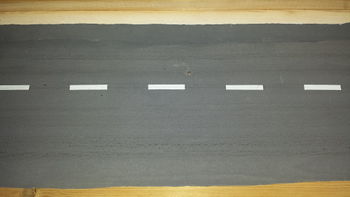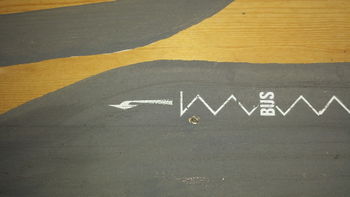Difference between revisions of "Fire engines automatic"
m (→Es werden zwei Einsatzstellenarten unterschieden:) |
m (→3.) Loeschzugfunktion (DC07/DC08 ab Firmware 10/2014)) |
||
| Line 66: | Line 66: | ||
<br> | <br> | ||
| − | ==3.) | + | == 3.) Convoy function (DC07 / DC08 as of firmware 10/2014) == |
<br> | <br> | ||
| − | + | Inserts that require more than one vehicle are with the extended fire engine only very cumbersome and absolutely not exemplary feasible. <br> | |
| − | + | Each vehicle that passed the first magnet has to travel over the second magnet to perform the appropriate functions at the job site. <br> | |
| − | + | It looks very strange, when each vehicle arrives individually and leaves. Therefore, a new function is now built into the DC-07 / DC08 decoder which allows you to | |
| − | + | that any number of vehicles move out to a job site, arrive together and drive back to the station together. <br> | |
<br> | <br> | ||
| − | + | For this, each vehicle in CV100 must have the genus 10 and in CV111 the value 1 or 123. <br> | |
| − | + | The vehicle, which after passing over the first magnet (start of the fire engine), passes over the second magnet (place of application), <br> | |
| − | + | automatically sends a signal to the following emergency vehicle, whereupon it stops and performs the same functions as if it had just driven over the second magnet. <br> | |
| − | + | Each subsequent vehicle with o.g. setting executes the corresponding functions. <br> | |
| − | + | After the set time (i.d.R., 20sec.) The vehicles will drive back to their starting point at moderate speed and without any special signal. <br> | |
| − | + | All vehicles that have not yet driven over the second magnet must now drive over it. <br> | |
| − | + | The magnet is ignored so as not to trigger the fire engine again. Only with the next magnet does the fire engine start again. <br> | |
<br> | <br> | ||
[https://www.youtube.com/watch?v=VpZ9MZ-VZJI Video: Ablauf: Löschzugautomatik]<br> | [https://www.youtube.com/watch?v=VpZ9MZ-VZJI Video: Ablauf: Löschzugautomatik]<br> | ||
Revision as of 21:13, 22 December 2017
Fire engine automatic
Each DC car decoder has a built-in fire engine automatic. This is similar to the Busautomatic, but has a very different job and the functions are different too.
It is thus possible to run real firefighting operations completely automatically, or to switch the special signal system of an emergency vehicle on and off without additional controls.
With CV100 and CV111 this fire engine is activated.
Of course, all other types of emergency vehicles (police, ambulance, etc.) can be equipped with it.
What do you need for this?
1x emergency vehicle with DC car decoder
1x Hall sensor on the vehicle floor
Two magnets in the roadway
one at the place where the mission should begin (e.g., fire station)
one at the job site (where the emergency vehicle should stop)
There are three types of operation:
1.) Simple fire engine (CV111 = 0)
If the emergency vehicle drives over the first magnet, the blue lights and the front flashers are activated.
If you have a DC car sound module connected, this will be activated too.
When driving over the second magnet blue light, front (sound) are switched off again.
video: simple fire engine procedure
2.) Extended fire engine (CV111 = 1 or 123)
The extended fire engine simulates a real fire brigade. Once the emergency vehicle has passed the first magnet,
Turns on blue lights, front flashers (sound) and drives with drive level 28 to the site.
Once it has reached the place of use (2nd magnet in the road), it stops and switches off the front sound (sound).
In addition, when CV111 is set to 123, light 2 and the light outputs defined in CV112 will be turned on.
The "duration of use" is factory set to 20 seconds and can be changed with CV103.
At the end of this time, the functions of CV 111 / CV112 and the blue lights will be switched off and the left turn signal and the distance control activated.
The emergency vehicle waits a moment to let a passing vehicle pass and then gets into traffic.
Afterwards it switches off the turn signal on the left again. The distance control stops the following vehicles and prevents a collision when placing them in current traffic.
A distinction is made between two types of deployment:
1.) In this case, it is possible to pass the traffic at the job site. If this is the case, CV100 must be set to 10.
This value specifies that the distance control is switched off during the stay at the job site. It also activates the delete pull function.
2.) All vehicles are stopped behind the emergency vehicle as long as the emergency vehicle is at the place of use. In this case, the CV100 must be set to the value 11.
Video: Ablauf erweiterte Feuerwehrautomatik
3.) Convoy function (DC07 / DC08 as of firmware 10/2014)
Inserts that require more than one vehicle are with the extended fire engine only very cumbersome and absolutely not exemplary feasible.
Each vehicle that passed the first magnet has to travel over the second magnet to perform the appropriate functions at the job site.
It looks very strange, when each vehicle arrives individually and leaves. Therefore, a new function is now built into the DC-07 / DC08 decoder which allows you to
that any number of vehicles move out to a job site, arrive together and drive back to the station together.
For this, each vehicle in CV100 must have the genus 10 and in CV111 the value 1 or 123.
The vehicle, which after passing over the first magnet (start of the fire engine), passes over the second magnet (place of application),
automatically sends a signal to the following emergency vehicle, whereupon it stops and performs the same functions as if it had just driven over the second magnet.
Each subsequent vehicle with o.g. setting executes the corresponding functions.
After the set time (i.d.R., 20sec.) The vehicles will drive back to their starting point at moderate speed and without any special signal.
All vehicles that have not yet driven over the second magnet must now drive over it.
The magnet is ignored so as not to trigger the fire engine again. Only with the next magnet does the fire engine start again.
Video: Ablauf: Löschzugautomatik
wichtige CV´s für die Nutzung der Feuerwehrautomatik
CV100 = legt die Fahrzeuggattung fest und definiert die Art der Einsatzstelle bzw. ob die Abstandststeuerung während des Aufenthaltes an der Einsatzstelle ein- bzw. ausgeschaltet ist
Wert 10 Abstandsteuerung bei Halt AUS, Aktivierung der Löschzugfunktion
Wert 11 Abstandsteuerung bei Halt EIN
CV101 = Blinkzeit für Funktionsbaustein E7
CV102 = Fahrstufe auf die abgebremst wird bei Funktionsbaustein E7
CV103 = Zeit in Sekunden, die ein Einsatzfahrzeug an einer Haltestelle wartet, wenn es einen Halt-Befehl vom Funktionsbaustein E2 bis E5 bekommt bzw. nach erkennen des 2. Magneten.
Ist dieser Wert 0, dann wird die automatische Abfahrt nicht eingeleitet.
CV104 = Blinkzeit für den linken Blinker. Gültig für Funktionsbaustein E6 oder Automatik für Bus und Einsatzfahrzeug. Die Zeit bestimmt, wie lange ein Fahrzeug links blinkt, bevor es losfährt.
Hat das Fahrzeug die Gattung 10 oder 14, so wird die Abstandssteuerung mit dem Einschalten des Blinkers wieder aktiviert. Der nachfolgende Verkehr wird angehalten,
damit sich das Fahrzeug nach Ablauf der Zeit wieder in den fließenden Verkehr einfädeln kann. Die Zeit sollte so bemessen sein, dass der Verkehr auf jeden Fall an dem stehenden Fahrzeug
vorbeigefahren ist, bevor dieses wieder losfährt.
CV105 = Fahrstufe mit der ein Einsatzfahrzeug aus der Einsatzstelle anfährt. Gültig für Funktionsbaustein E oder Automatik für Bus und Einsatzfahrzeug
CV106 = Blinkzeit für den linken Blinker nach der Ausfahrt. Gültig für Funktionsbaustein E oder Automatik für Bus und Einsatzfahrzeug. Bestimmt die Zeit,
wie lange der linke Blinker noch eingeschaltet bleibt,nachdem das Fahrzeug aus der Einsatzstelle losgefahren ist.
CV107 = Zeit in der während eines automatisch eingeleitetem Abfahrbefehls kein erneuter Haltebefehl angenommen wird. Gültig für Funktionsbaustein E.
Diese Zeitfenster verhindert, dass durch den Haltebefehl des Funktionsbausteins das Fahrzeug sofort wieder angehalten wird.
CV108 =Haltezeit für Funktionsbaustein D1 – D4
Wert 0 = hält so lange bis ein An- oder Abfahrbefehl empfangen wird
Wert 1-63 = hält 1-63 Sekunden
CV111 = Aktiviert die Feuerwehrautomatik
Wert 0 = einfache Feuerwehrautomatik aktiv
Wert 1 = erweiterte Feuerwehrautomatik aktiv
Wert 123 = erweiterte Feuerwehrautoamtik aktiv, nach erreichen des 2. Magneten wird Licht 2 für Dauer des Aufenthaltes eingeschaltet
CV112 = Definition der Funktionen während des Halts
Wert 1 = Linker Blinker
Wert 2 = Rechter Blinker
Wert 3 = Warnblinker
Wert 4 = Licht 2
Wert 5 = Licht 3 (Abhängig von CV20)
Wert 16 = Licht 4 (Abhängig von CV20)
Wert 32 = Blaulichter
Wert 64 = Frontblitzer
Wert 128 = Fahrlicht
Bestellen des DC-Car mit Einstellung
Wenn sie keine eigene Einstellmöglichkeit (Digitalzentrale oder CV-Programmer) haben, können sie auch die Einstellungen mitbestellen.
Bei der Bestellung angeben
Busautomatik:
| Einsatzstelle der Straße | O | IR-AUS | CV100=14 |
| Einsatzstelle auf der Straße | O | IR-AN | CV100=15 |
Stillstand:
| mit Innenlicht /Arbeitslicht = Licht2 | O | CV111=123 |
| ohne Innenlicht /Arbeitslicht = Licht2 | O | CV111=1 |
| mit Warnblinker | O | CV112=3 |
| ohne Warnblinker | O | CV112=0 |
| Wartezeit | ? | CV103 Angeben (0-63 Sekunden) |



